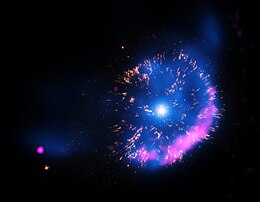
Back بقايا مستعر Arabic Romanent de nova Catalan Resto de nova Spanish Resto di nova Italian 新星残骸 Japanese 신성잔해 Korean Остаток од нова MK Pozostałość po nowej Polish Remanescente de nova Portuguese Остаток новой Russian

A nova remnant is made up of the material either left behind by a sudden explosive fusion eruption by classical novae, or from multiple ejections by recurrent novae. Over their short lifetimes, nova shells show expansion velocities of around 1000 km/s,[1] whose faint nebulosities are usually illuminated by their progenitor stars via light echos as observed with the spherical shell[1] of Nova Persei 1901[2] or the energies remaining in the expanding bubbles like T Pyxidis.[3]
- ^ a b Lloyd, H.M.; O'Brien, T.J.; Bode, M.F. (1997). "Shaping of nova remnants by binary motion" (PDF). Monthly Notices of the Royal Astronomical Society. 284 (1): 137–147. Bibcode:1997MNRAS.284..137L. doi:10.1093/mnras/284.1.137.
- ^ Liimets, T.; Corradi, R.L.M.; Santander-García, M.; Villaver, E.; Rodríguez-Gil, P.; Verro, K.; Kolka, I. (2014). A dynamical study of the nova remnant of GK Persei / stella novae: Past and future decades. Stellar Novae: Past and Future Decades. ASP Conference Series. Vol. 490. pp. 109–115. arXiv:1310.4488. Bibcode:2014ASPC..490..109L.
- ^ Ogley, R. N.; Chaty, S.; Crocker, M.; Eyres, S. P. S.; Kenworthy, M. A.; Richards, A. M. S.; Rodriguez, L. F.; Stirling, A. M. (April 2002). "A search for radio emission from Galactic supersoft X-ray sources". Monthly Notices of the Royal Astronomical Society. 330 (4): 772–777. arXiv:astro-ph/0111120. Bibcode:2002MNRAS.330..772O. doi:10.1046/j.1365-8711.2002.05130.x. S2CID 3047485.